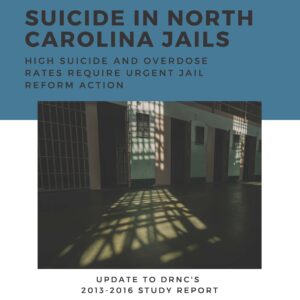

In one week in early November two civil society organizations, one in England one in North Carolina, forced their respective state agencies to `discover’ yet again that the entire so-called criminal justice system is built on deaths “by suicide”. In North Carolina, Disability Rights North Carolina issued its report, Suicide in North Carolina Jails: High Suicide and Overdose Rates Require Urgent Jail Reform Action. In England, Inquest released its report, Deaths of people following release from prison. While the numbers are grim and the personal accounts are heartbreaking, who is surprised by the data and whose hearts are broken? If we were surprised, if we still had hearts to break, we would have done something serious long before this month’s reports.
Remember March 2015 when it was “discovered” that the year before prison suicides in England and Wales reached a seven-year high, according to the Howard League for Penal Reform, the Prison and Probation Ombudsman for England and Wales, and the House of Commons Justice Committee?
Remember April 2015 when it was reported that, in the United Kingdom, the number of suicide attempts in “immigration removal” centers was at an all-time high?
Remember August 2015 when the U.S. Federal Bureau of Justice Statistics released Mortality in Local Jails and State Prisons, 2000–2013 – Statistical Tables and reported suicide was the leading cause of death in U.S. jails; the Spokane County Jail, in Washington State, requested that the U.S. Department of Justice investigate a recent rash of prisoner suicides; and, reluctantly and under pressure from the Federal government, the Los Angeles County Sheriff’s Department agreed to reforms in the L.A. County Jail that would finally begin to address “chronically poor treatment for mentally ill inmates and … years of abusive behavior by jailers?
Remember April 2016 when United Kingdom’s Ministry of Justice released Safety in Custody Statistics England and Wales / Deaths in prison custody to March 2016, and the numbers were bad, the worst in 25 years?
Remember August 2016 when, according to a Howard League report on England and Wales, “2016 becomes worst year ever recorded for suicides in prisons”?
Who remembers the names and lives of those women who ostensibly died “at their own hands” … over and over and over again; the reports of their demise and then later the “discoveries” that implicated State malfeasance; the reports by civil society organizations, because the State doesn’t even try to keep adequate statistics, much less anything like adequate care? Who remembers?
In North Carolina, the situation is typical. The rate of suicide in jail is rising precipitously. Those who die by suicide are generally 40 years old or younger. Suicide happens quickly: 20% occur within 24 hours of entering; 65% within seven days; 80% within 12 days. Surviving two weeks in jail is a small miracle. 85% of those deemed suicides died by hanging. 95% died before ever facing a trial. They were formally innocent, but they were executed, nevertheless. And what of all the others, the ones who were in the cells next to those who died by hanging?
According to Inquest’s report, “In the most recent recorded year, ten people died each week following release from prison. Every two days, someone took their own life. In the same year one woman died every week, and half of these deaths were self-inflicted.” According to Inquest’s report, the suicide rate for women in the general population is a little less than 5 per 100,000. For women on “post-release supervision”, the rate last year was 459 per 100,000. This discrepancy is even more noteworthy when we consider that “in the general population men are more likely to die by suicide than women. However, when we look to people in the criminal justice system – whether in prison or under probation supervision – women are at a higher risk of a self-inflicted death than men.” For that reason Inquest “reframes deaths in custody as a form of violence against women.”
Where is the supervision; what comprises supervision in North Carolina, the United Kingdom, and beyond, when levels of suicide either go unreported, meaning there’s no attention paid, or, worse, go untreated, because those deaths just don’t matter? If anything, the systemic and accelerating years long rise in suicide among people, particularly women, in prison and under post-confinement supervision, suggests suicide has become a State solution to the so-called recidivism crisis, a crisis manufactured by the State.
We are once more still in the everyday political economy of necropower, where “weapons are deployed in the interest of maximum destruction of persons and the creation of death-worlds, new and unique forms of social existence in which vast populations are subjected to conditions of life conferring upon them the status of living dead … Under conditions of necropower, the lines between resistance and suicide, sacrifice and redemption, martyrdom and freedom are blurred.” It’s time, it’s way past time, to remember and, in remembering, to move through and beyond the blur of reiterated discovery to action. Stop sending people to jail, close the jails and the prisons, and, in so doing, begin to end the massacre. Don’t forget.
(Image Credit 1: Disability Rights North Carolina) (Image Credit 2: Inquest)